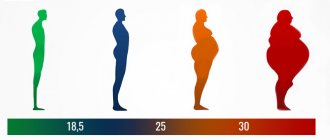Hirsutism in women is a pathology of the endocrine system, in which the patient begins to actively grow hair according to the male type.
Unfortunately, the disease is not limited to excess hair alone: a woman also has to deal with other hormonal disorders. First of all, the menstrual cycle is disrupted, uterine bleeding and anemia may also occur, and often such women become infertile.
According to medical statistics, approximately 8 out of a hundred women experience this type of disorder. These figures are somewhat lower than the statistics on the incidence of diffuse toxic goiter, but this is largely due to the fact that the disease is unique to women.
Sometimes the manifestations of the disease are so obvious that a woman has to look for ways to mechanically combat unwanted hair. Moreover, as can be seen in the photo of hirsutism in women, this hair is hyperpigmented, that is, noticeably different in color from the rest of the hair on the body.
Unfortunately, this disease is not only a cosmetic problem: it is a serious pathology that requires correction by several specialists, primarily a gynecologist and endocrinologist.
1.General information
The term “hirsutism” remains controversial to this day. The domestic literature emphasizes that it is applicable only to females who exhibit intense male-type hair growth - in those areas where women should not normally have hair. However, in Western sources, especially English-language ones, hirsutism is interpreted more broadly and also applies to men with excessive and abnormally localized hair growth. In the International Classification of Diseases (ICD), this pathological phenomenon belongs to the dermatological heading (“Diseases of the skin and subcutaneous tissue”) and is considered a special case of hypertrichosis - excess hair growth throughout the body, regardless of gender.
Hirsutism as a clinically significant condition occurs, according to various estimates, in 5-15% of women of any ethnicity and any region of residence. Mild hirsutism as a cosmetic problem is much more widespread: according to recent special studies, up to 40% of all women on the globe would like to get rid of unwanted hair, primarily on the face.
A must read! Help with treatment and hospitalization!
Procedures for hirsutism in women
- Shaving, bleaching, waxing. Many cosmetologists and doctors believe that in case of hirsutism, these procedures are strictly prohibited, since women's skin is very delicate, and such manipulations cause irritation, redness and inflammation, and this, in turn, provokes the appearance of even more hairs, as well as their ingrowth.
- Depilatory creams are an acceptable method as they do not cause the above symptoms.
- Laser hair removal and photoepilation are considered the most effective and harmless method, since they stop hair growth and do not cause inflammation or ingrown hairs.
The prognosis for hirsutism is not the most favorable; it is not possible to completely get rid of the disease. However, the patient can stop hair growth, thereby significantly improving her quality of life!
Related articles: Laser hair removal - contraindications
2. Reasons
The main cause of hirsutism today is considered to be hyperandrogenemia - an excessive concentration of male sex hormones in the blood. Like other hormones, androgens are involved in the regulation of a large number of physiological processes (growth, the formation of sweat and sebum, sexual desire, in men - maintaining potency, insulin secretion, etc.). In turn, increased production of androgenic hormones can be caused by a tumor process or hyperplasia (proliferation) of the adrenal cortex, a number of ovarian diseases (polycystic disease, neoplasms, hypertrophy, etc.), as well as disorders of the hormonal activity of the pituitary-hypothalamic system of the brain (which is observed for example, with Itsenko-Cushing's disease, prolactinoma, acromegaly).
The role of a hereditary factor, hormonal changes in a woman’s body (pregnancy, menopause), taking hormone-containing drugs, anabolic steroids, and antiparoxysmal drugs is considered to be proven.
At the same time, we have to admit that in a very significant proportion of cases, hirsutism is classified as idiopathic, i.e. due to unknown or purely individual reasons.
Visit our Gynecology page
Consequences
Increased hairiness in our time causes serious emotional discomfort to women and forces them to undergo many cosmetic procedures. If you don’t notice the problem for a long time and don’t look for a solution, you can seriously neglect your health, which will lead to the following consequences:
- baldness;
- development of female infertility of various nature;
- endometrial hyperplasia;
- insulin resistance;
- diabetes;
- hyperlipoproteinemia.
3. Symptoms and diagnosis
There are vellus hairs (soft, almost colorless, thin, unnoticeable) and terminal hairs (hard, thicker and intensely pigmented). With hirsutism, transformation of vellus hair into terminal hair occurs, and in the so-called androgen-dependent areas, i.e. in areas where terminal hair growth is characteristic exclusively of the male sex (above the upper lip, chin, cheeks, on the chest, especially around the nipples, on the back, in the area from the pubis to the navel, on the inner surfaces of the thighs, buttocks). At the same time, there is often a tendency to alopecia, i.e. to loss and thinning of hair on the head. In some cases, hirsutism is accompanied by dys- or amenorrhea, increased sweating and oily skin, and infertility (inability to become pregnant). If the causes are not eliminated and the pathology continues to progress, general virilization (acquisition and/or strengthening of secondary sexual characteristics characteristic of the opposite sex) joins hirsutism: the voice becomes rougher, the emotional background and reaction changes, libido sharply increases, body weight increases, according to the male type the distribution of muscle and fat tissue changes. Further progression can lead to shrinkage of the mammary glands and labia, “drying out” of the vagina, and enlargement of the clitoris.
Of course, such metamorphoses have the most detrimental effect on a woman’s psychological state, leading to the formation of feelings of inferiority, social maladaptation and self-isolation, and the development of depressive and anxiety-neurotic disorders.
Diagnosis of hirsutism requires the most careful and detailed study of all significant anamnestic information and nuances: the nature and regularity of menstrual function, the composition of previously or continuously taken drug therapy, heredity, age of onset and dynamics of the condition, the presence of concomitant and background endocrine, somatic, oncological, gynecological diseases ( for example, the combination of hirsutism with diabetes mellitus received the independent name “Achard-Tiers syndrome” or “diabetes of bearded women”). Detailed studies of the biochemical and hormonal composition of the blood, dermatological and a number of other specialized examinations are carried out, incl. using instrumental methods (ultrasound, MRI, diagnostic laparoscopy, biopsy, etc.).
About our clinic Chistye Prudy metro station Medintercom page!
Assessing the degree of female hairiness
Not all hair on the body is superfluous and, perhaps, you consider that vegetation that is physiologically acceptable and grows within normal limits to be superfluous. The Ferriman-Gallwey scale is used for assessment. The scale has 4 rating options (you can find comparative photos on the Internet): 0 - hair is completely absent, 4 - hair growth is well expressed. This scale evaluates vegetation in the following locations: above the upper lip, in the abdomen, back, chest, pubic area, arms and inner thighs. If you evaluate the degree of hair growth in all these places and score 8 points, then you can assume the presence of pathology.
4.Treatment
Therapeutic approaches in this case are extremely diverse, since it is not hirsutism as such that must be eliminated, but the causes that determine it. Often, the hirsute tendency is reduced without additional effort after successful surgery on the ovaries, adrenal glands, etc., when it is possible to normalize hormonal levels by removing a tumor or hyperplasia. In other cases, the key to cure is the abolition of medications taken or, conversely, the prescription of corrective hormonal antiandrogen therapy, which, however, has a number of contraindications. When hirsutism is combined with excess body weight, measures must be taken to normalize the diet and lifestyle. Finally, with idiopathic, etiologically unclear hirsutism, one has to limit oneself to palliative methods of aesthetic medicine, the arsenal of which, however, is very extensive and the effectiveness is quite high.
Treatment can take a long time (up to a year or more) and require remarkable patience, will, and a therapeutic alliance with the attending physician from the patient. The prognosis with the right comprehensive approach, including evidence-based diagnosis and adequate therapy, is always favorable.
Diagnosis of increased hairiness in a girl
If you have a problem and want to fix it, the first step is to contact a specialist. The following specialists deal with this problem: endocrinologist, gynecologist, dermatologist. A specialist will study your problem and, if necessary, tell you what tests to take and what procedures to carry out.
The doctor examines the patient’s medical history and is also interested in the following questions:
- what medications the patient takes, for how long, for what purpose;
- whether there is a menstrual irregularity;
- whether there are relatives with similar symptoms.
The doctor also prescribes the necessary laboratory blood tests: for certain hormones, as well as biochemical and general blood tests.
If necessary, the following studies are carried out to clarify the picture:
- Ultrasound of the pelvic organs;
- It is possible to conduct an MRI or CT scan of the adrenal glands, pituitary gland, hypothalamus.
What is hirsutism, causes and methods of correction
from April 14, 2020
Since ancient times, women have strived for a perfect and beautiful body, and all this time they have been faced with the problem of excess growth of unwanted hair and its removal. It is no secret that excessive hair growth causes moral damage to a woman, reduces her self-esteem, and in addition, this may hide an endocrine disease.
What is meant by excess hair growth or hirsutism?
Hirsutism (from the Latin word hirsutus) - shaggy, hairy - is male-type in women typical places : upper lip, chin, sternum area, linea alba, upper back, inner thighs . In this case, thin and vellus hair is replaced with hard, long and pigmented – terminal hair. Hirsutism is quantified using the Ferriman-Gallway scale as 8 or more points.
What is hypertrichosis and how does it differ from hirsutism?
Hypertrichosis is the degeneration of fine vellus hair into coarse terminal hair and its excessive growth in places where normally there should only be vellus hair. Hypertrichosis, unlike hirsutism, can be observed in both women and men , taking into account national characteristics and age. Thus, the growth of vellus hair on the lower legs of women is the norm. When excess terminal hair growth occurs, this situation is called hypertrichosis. In men, chest hair growth is considered normal. However, the appearance of too much hair on a man's chest will be called hypertrichosis. But the appearance of terminal hair on the chest in women is called hirsutism.
Endocrine causes of excess hair growth on the face and body in women
The reasons for the development of hirsutism can be either endocrine - due to hormonal imbalance - or non-hormonal.
Endocrine causes include excess production of male hormones - androgens in a woman’s body (in the ovaries or adrenal glands) with various dysfunctions and polycystic ovaries. Hirsutism can also occur with insulin resistance, Cushing's disease, hypothyroidism and obesity.
Non-hormonal causes of hirsutism in women:
- familial hirsutism (constitutional) is hereditary in nature and often occurs in women who live in certain geographical areas,
- exogenous hirsutism occurs due to additional intake of medications containing androgens, corticosteroids and other medications, or under the influence of stress, prolonged hunger, etc.
- idiopathic hirsutism is excessive hair growth in women of the male type of unknown cause, when during the examination the endocrine nature of the disease was excluded, the influence of exogenous factors was excluded and there were no hereditary causes.
Idiopathic hirsutism may be associated with:
- with increased sensitivity of hair follicles to the action of male sex hormones-androgens,
- with an increased number of hair follicle receptors for androgens,
- with increased enzyme activity (5-α reductase), which enhances the transition of the male sex hormone testosterone into its active fraction - dihydrotestosterone.
Ovarian dysfunction (usually polycystic ovary syndrome) and idiopathic hirsutism account for approximately 90% of all cases of excess hair growth in women .
Why is hirsutism dangerous?
Excessive hair growth in itself does not threaten life and health, however, hirsutism can be a consequence of various endocrine diseases. It is important to be properly examined in order to exclude or confirm one or another endocrine disease.
Our clinic - the National Medical Research Center for Endocrinology of the Ministry of Health of the Russian Federation - is a leading medical institution in Russia, where comprehensive treatment of hirsutism , taking into account the endocrine causes of the disease and their elimination.
With such an integrated approach to the treatment of hirsutism, we can guarantee the patient the achievement of effective results in the radical elimination of excess hair growth.
Treatment algorithm for hirsutism and hypertrichosis in our clinic:
- Your call to +7 (495) 500-00-97
- Consultation with a dermatocosmetologist
- According to indications (according to complaints), consultation with specialists: gynecologist-endocrinologist, endocrinologist, etc.
- Examination and clarification of the cause of the disease
- Prescription of treatment based on examination results
- Choosing an hair removal method taking into account the causes of the disease and contraindications
- Hair removal procedures
Our specialists have the maximum possible number of professional hair removal methods :
Waxing is a procedure for removing hair using wax at a certain temperature. The advantages of the method are the absence of contraindications, the ability to treat any part of the body or the entire body in a short time, and the low cost of the procedure. The main disadvantage is that hair removal is performed without destroying the hair follicle and has a temporary aesthetic effect. In addition, there is a possible risk of ingrown hairs.
Photoepilation is one of the most effective and radical methods of hair removal. From the very first procedures, the hair becomes thinner and becomes almost invisible, and in 6-8 sessions the hair follicle is completely destroyed. In our center, the procedure is performed on a high-tech multifunctional laser system - Quantum, with a working intense pulsed light (IPL) emitter - Quantum HR.
The method is effective, BUT it has many disadvantages: it removes only dark hair on light skin, it requires the mandatory application of contact gel during the procedure, photoepilation procedures are not performed in the summer.
Laser hair removal is the most effective modern method of radical removal of unwanted hair on the face and body in women and men. During global clinical practice, this method has been recognized as the safest for health and the most effective in the treatment of hirsutism and hypertrichosis. In our clinic, laser hair removal procedures are performed using the most advanced professional diode laser Palomar Vectus , USA. Any area of the skin - face (upper lip, chin, eyebrow line), armpits, thighs, bikini area, arms and legs - acquires a well-groomed appearance for many years.
It is important to remember, even with full-volume hair removal, it is necessary to carry out complex therapy for hirsutism and hypertrichosis in women when endocrine problems are identified in order to achieve the most effective result in eliminating unwanted hair growth.
Federal State Budgetary Institution National Medical Research Center of Endocrinology of the Russian Ministry of Health
Did not find an answer to your question? Call and ask the specialists by phone +7 (495) 500 00 97 or write +7 (910) 455 34 97
Share with your friends and acquaintances:
How to treat excessive hairiness in a girl
There are several treatments for hypertrichosis in women. Let's look at medical treatments and methods that help hide hairiness in girls.
Treatment
The key to effective treatment is sufficient diagnosis, as a result of which the cause of the development of the disease was determined. Depending on what caused it and the individual characteristics of the person, treatment is prescribed:
- hormone therapy (oral contraceptives);
- Often, losing excess weight helps bring hormones back to normal without taking additional medications;
- the use of drugs that block androgens (male sex hormones).
It is worth remembering that bringing hormonal levels back to normal takes several months or more; this is a long process that requires constant compliance with the doctor’s instructions.
If hypertrichosis is caused by neoplasms or physiological characteristics of certain organs, then surgical intervention may be prescribed.









